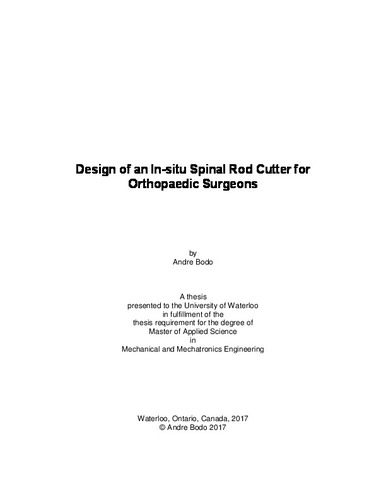UWSpace will be migrating to a new version of its software from July 29th to August 1st. UWSpace will be offline for all UW community members during this time.
Design of an In-situ Spinal Rod Cutter for Orthopaedic Surgeons
| dc.contributor.author | Bodo, Andre | |
| dc.date.accessioned | 2017-09-20 12:59:58 (GMT) | |
| dc.date.available | 2017-09-20 12:59:58 (GMT) | |
| dc.date.issued | 2017-09-20 | |
| dc.date.submitted | 2017-08-23 | |
| dc.identifier.uri | http://hdl.handle.net/10012/12403 | |
| dc.description.abstract | As spine deformities scoliosis and kyphosis progress in severity, surgical treatment is often required. Implant rods are attached by bone screws to the spinal vertebrae to correct these deformities and stabilize the spine. It can be difficult to cut these rods to the ideal length before implantation and sometimes these rods are too long and must be cut in-situ. Also, when revision surgery is performed to replace a rod section, in-situ rod cutting must be performed. The rods are difficult to cut and only manual rod cutting tools are available. These rod cutters are physically demanding to use and difficult to position while avoiding any spurious with the exposed spine. There is a clear need for an improved in-situ rod cutter. Thus, the objective of this thesis is to develop a new and improved design for an in-situ rod cutter. Experimental work was done to show that shear cutting and bolt-cutting techniques produced the most desirable results for cutting spinal rods in-situ. The shear cutting techniques required slightly less force than bolt cutting techniques and produced a cleaner rod cut with less deformation. It was found that cutting force increased with the diameter of the spinal rod, regardless of the rod material. Constraints and criteria were established to guide the design of a new in-situ rod cutter. It was decided that any attempt at designing a new in-situ cutter must include a non-manual power source for operation. Two design alternatives, a shear cutting design and bolt-cutting design were presented and scored in an engineering design process. A shear cutter design was initially chosen and work was done to implement the shear cutter design. However, the prototype fractured in initial testing and the shear cutter design was abandoned. A bolt-cutter design was then developed and a 3D printed prototype was made to demonstrate the mechanism involved. Analysis was performed to estimate the mechanical advantage of the mechanism used to amplify the force applied by a pneumatic cylinder used as the power source. Further development was required to implement the bolt-cutting design but initial progress in this design project was achieved. It is recommended that stress analysis, prototyping and testing be done to move this design towards application in spinal surgery. | en |
| dc.language.iso | en | en |
| dc.publisher | University of Waterloo | en |
| dc.subject | Surgical Tool | en |
| dc.subject | Rod Cutter | en |
| dc.subject | Engineering Design | en |
| dc.subject | Spinal Rod Cutter | en |
| dc.subject | Mechanical Design | en |
| dc.title | Design of an In-situ Spinal Rod Cutter for Orthopaedic Surgeons | en |
| dc.type | Master Thesis | en |
| dc.pending | false | |
| uws-etd.degree.department | Mechanical and Mechatronics Engineering | en |
| uws-etd.degree.discipline | Mechanical Engineering | en |
| uws-etd.degree.grantor | University of Waterloo | en |
| uws-etd.degree | Master of Applied Science | en |
| uws.contributor.advisor | Medley, John | |
| uws.contributor.advisor | Parham, Rasoulinejad | |
| uws.contributor.advisor | Yang, Victor | |
| uws.contributor.affiliation1 | Faculty of Applied Health Sciences | en |
| uws.published.city | Waterloo | en |
| uws.published.country | Canada | en |
| uws.published.province | Ontario | en |
| uws.typeOfResource | Text | en |
| uws.peerReviewStatus | Unreviewed | en |
| uws.scholarLevel | Graduate | en |

